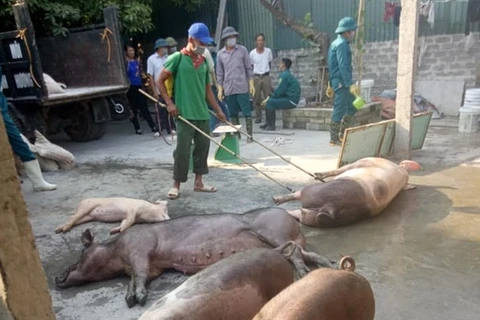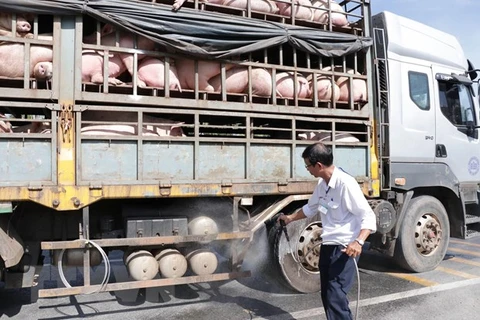Hanoi (VNA) - The complicated developments of the African swine fever caused a shortage of the meat supply in the market, leading to a hike in the prices of pork and processed products. This is also a cause of the CPI rise in December by 1.4 percent over November, marking the highest rise in the last months of the recent nine years. As a result, the yearly CPI rose by 5.23 percent over December 2018.
Revealing the information, head of the Statistics Department under the General Department of Statistics Do Thi Ngoc stressed that the average annual CPI rose only 2.79 percent over the same period a year earlier and this is the lowest of this category in the past three years.
According to the General Department of Statistics, the prices of 10 out of the 11 groups of main commodity and services rose over those in November.
340,800 tons of pork culled
As of December 19, nearly 6 million pigs totaling 340,800 tons or about 9 percent of the national figure had been culled to curb the spread of the African swine fever.
In the market, the price of port hiked 19.7 percent as a result of the short supply, leading to a rise in the prices of pork-based food. In face of the situation, consumers turned to substitutes like beef, poultry meat and aquatic products.
However, Ngoc said, as Christmas and lunar New Year were approaching, those products could not maintain stable prices. The price of beef rose by 2.04 percent, chicken 3.46 percent, fish and shrimp 1.12-1.55 percent, and processed aquatic products 1.11 percent.
A silver lining of the cloud pointed out by Ngoc was the favourabe weather conditions and the harvest of various kinds of vegetables which helped brought the prices of vegetables down.
Reports also said the national pork output was 3.3 million tons in 2019, 13.8 percent lower than the figure of 2018, and this adversely affected the pork prices and pushed the common CPI to rise by 0.83 percent.
Besides, the world market developments caused the prices of oil to increase by 1.27 percent over the month earlier and this also pushed the common CPI to rise by about 0.05 percent.
Household electricity consumption price rises 8.38 percent over 2018
2019 marks a year full of adverse developments of prices in both policy regulation and market.
The price of house electricity consumption was hiked on March 20, plus the higher demand caused by the hot weather caused the household consumption electricity price in 2019 to rise by 8.38 percent over a year earlier.
This was worsened by the hike in schooling fee, textbook price hike, and medical service price rise.
As for the market, the rising demand in the first two months of the year also caused the prices of food, eatery services, drinks, public transport services, and tourism to go up.
Besides, the prices of essential goods in the world like fuel and steel also fell into a rising trend and the prices of imported goods were estimated to rise by 0.59 percent, those of exports by 3.01 percent.
Besides, according to Ngoc, the basic inflation of 2019 also rose 2.01 percent over a year earlier.
“The common inflation rose higher than the basic inflation. This shows that the price changes are mainly caused by the hike in the prices of food, medical services, educational services and oil. The basic inflation in 2019 proves that the monetary policy is still being regulated stably,” Ngoc stressed./.
























